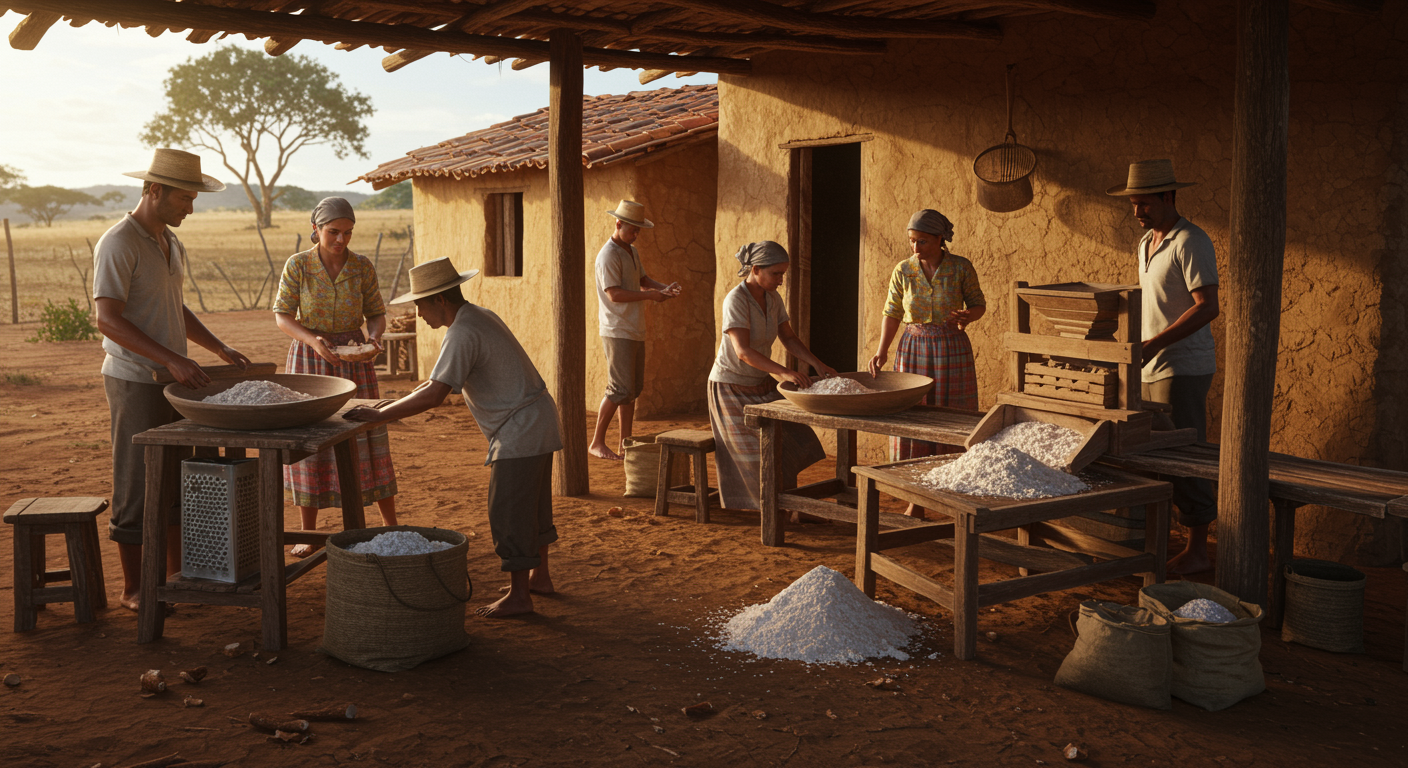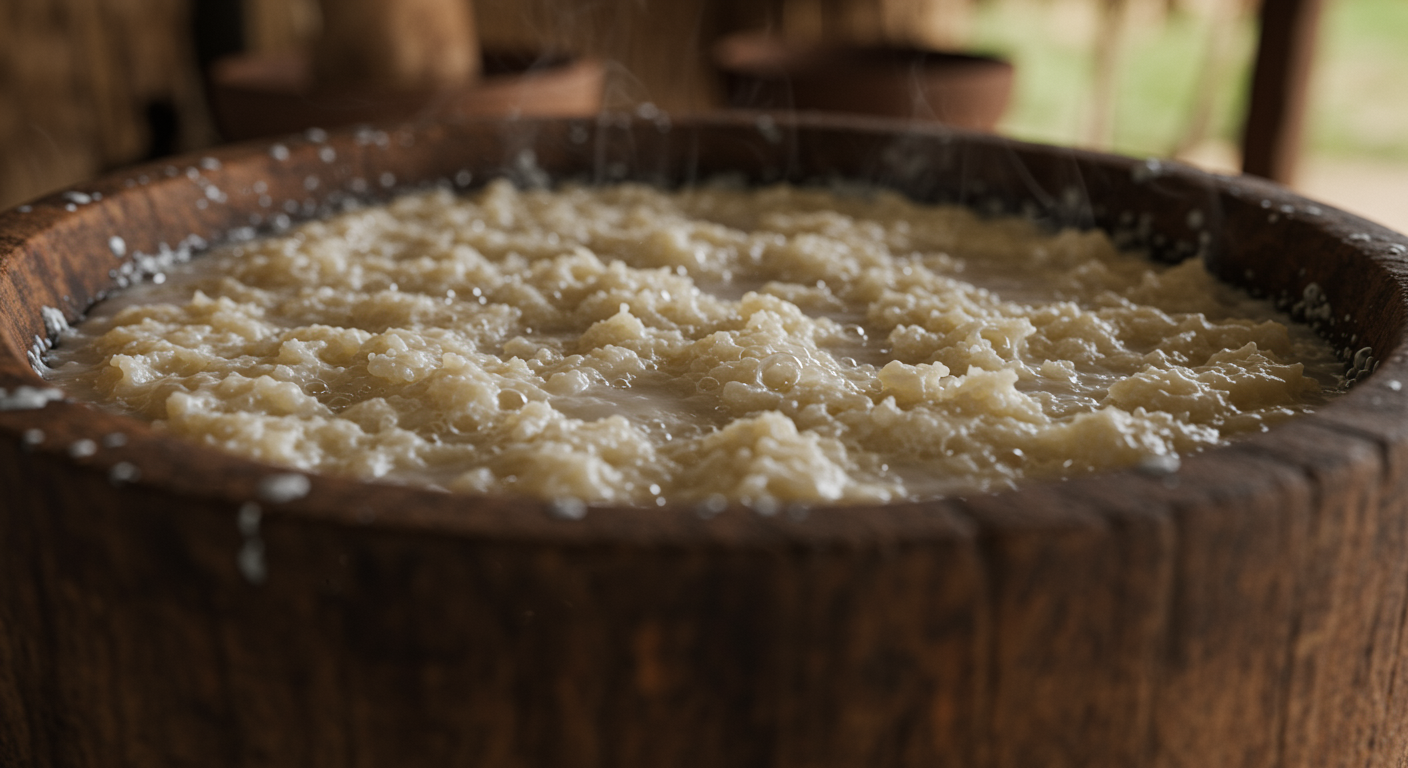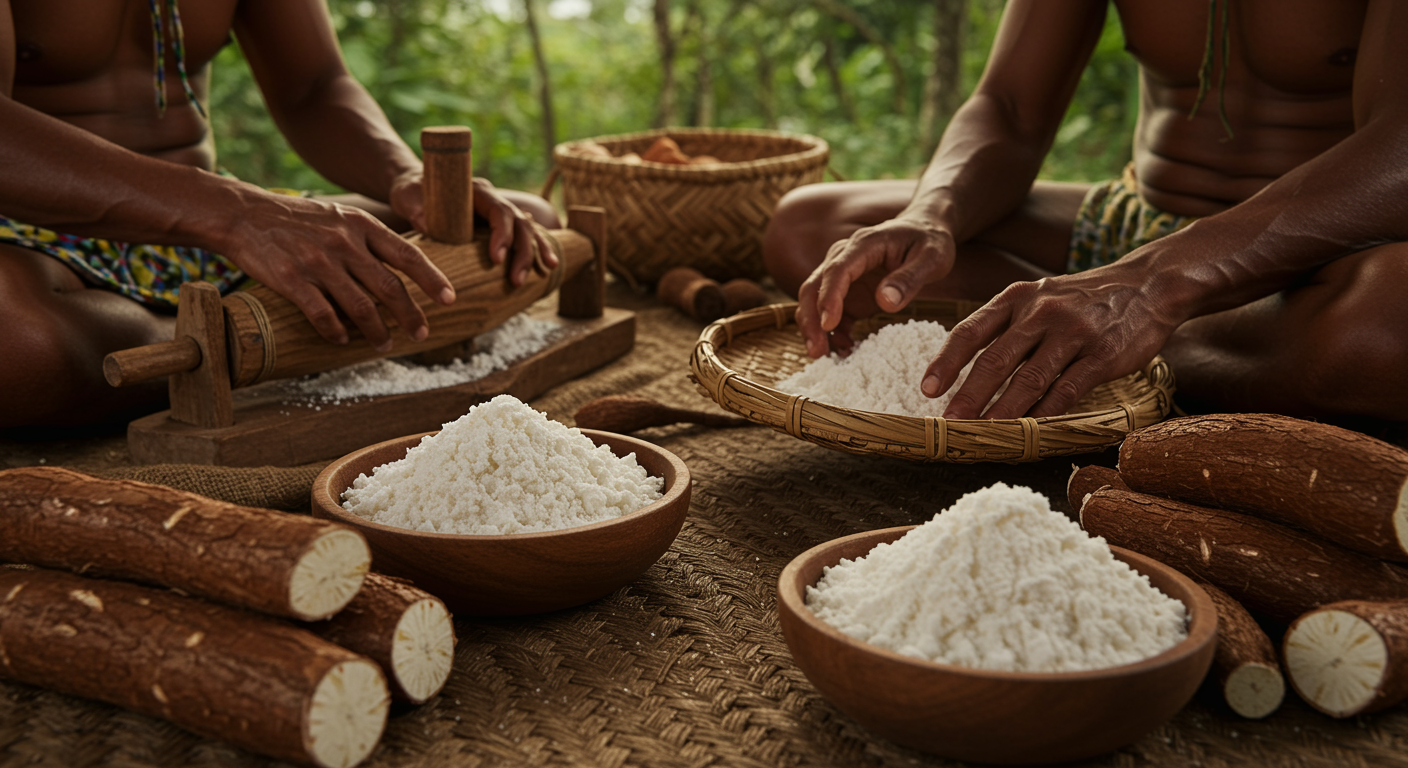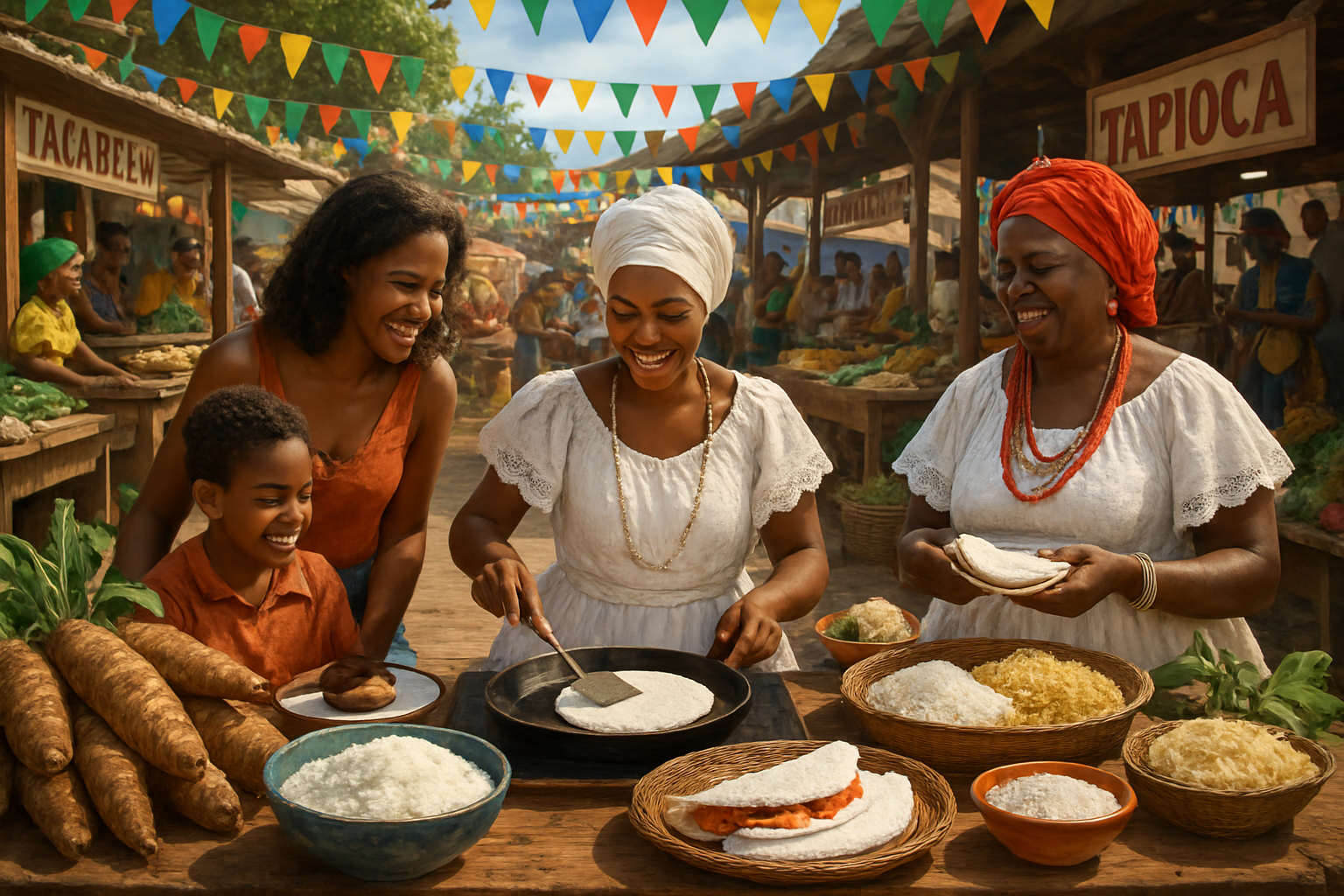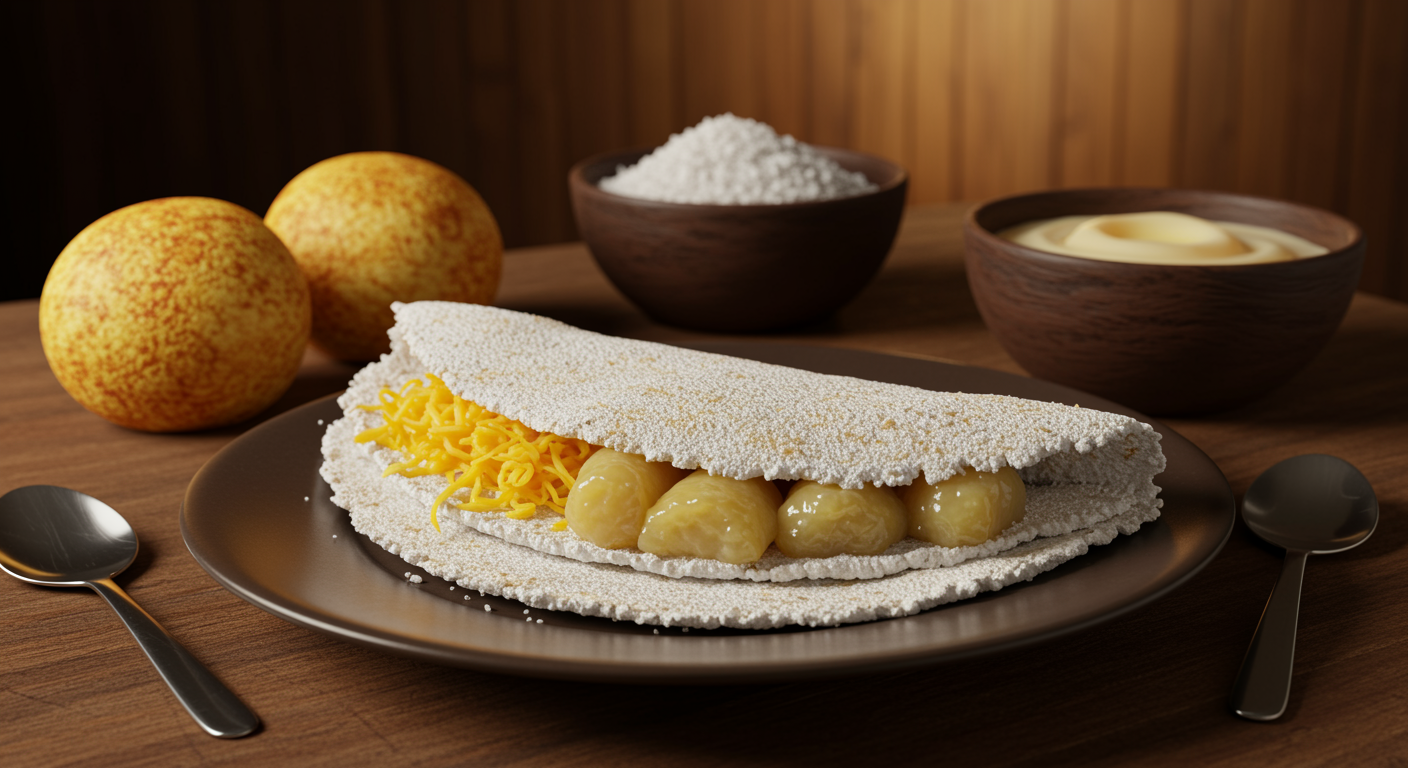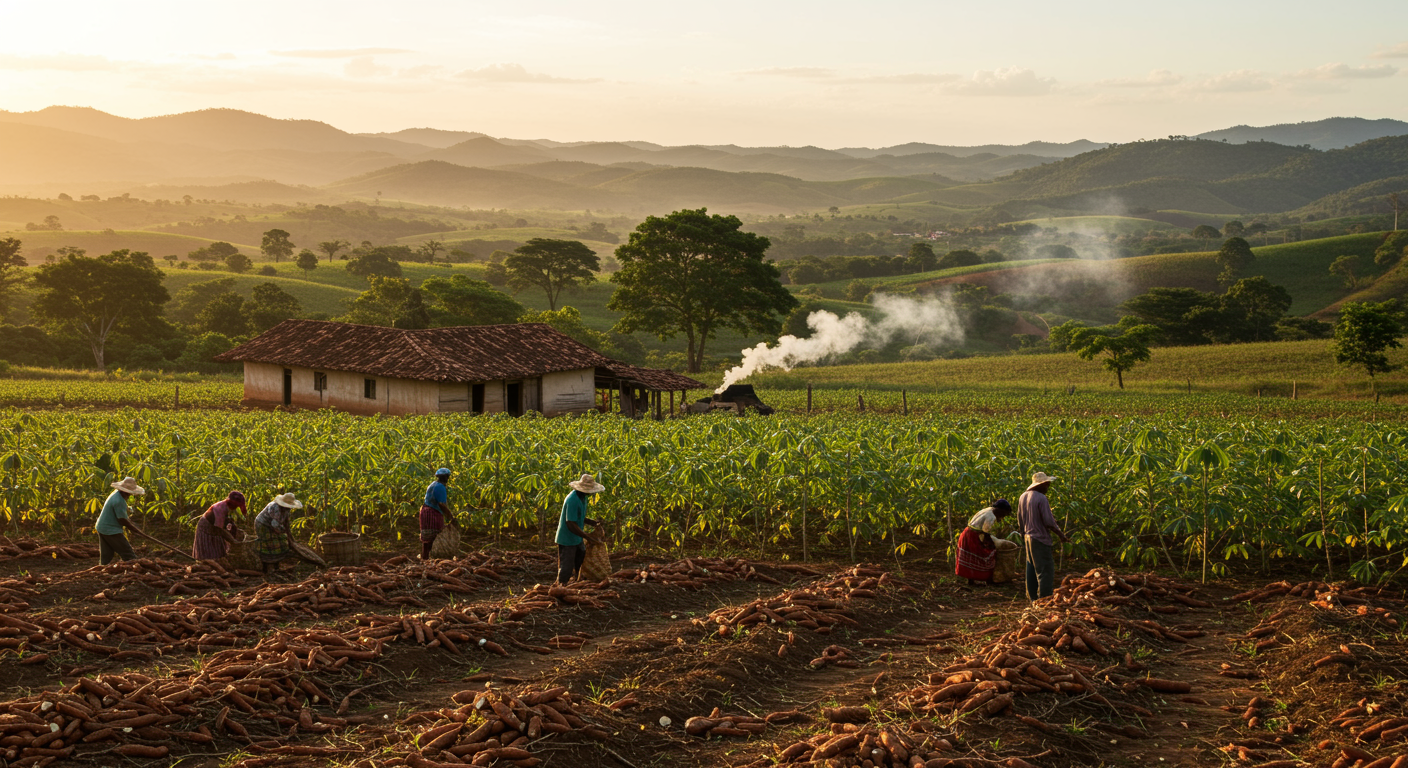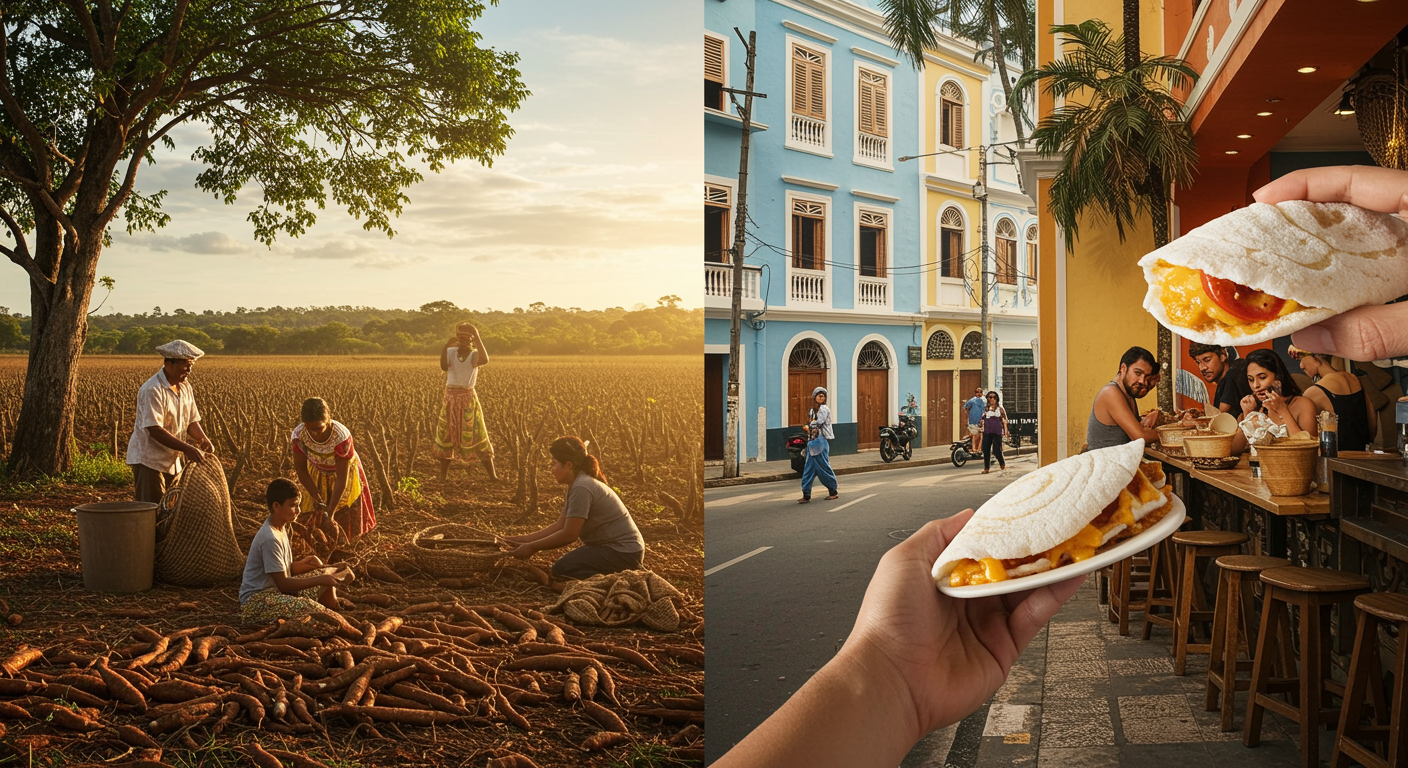In the arid and often challenging landscape of the Bahian sertão (backcountry), the production of tapioca goma (hydrated cassava starch) is far more than a simple agricultural task; it is a meticulously preserved artisanal process, a testament to ancestral knowledge, and a cornerstone of community survival and cultural identity. This intricate transformation of raw cassava root into the versatile starch staple is a deeply ingrained tradition, reflecting centuries of adaptation to environmental constraints and an unwavering commitment to sustainable practices. Delving into the artisanal process of goma production reveals the profound connection between the land, the labor, and the culinary heritage of the Bahian sertão, offering invaluable insights into the expertise and trustworthiness of these communities.
The Mandioca: A Resilient Foundation in the Sertão
The journey of tapioca goma begins with the resilient cassava plant (Manihot esculenta), known locally as mandioca or macaxeira. In the sertão, bitter cassava varieties are predominantly cultivated due to their remarkable drought resistance and higher starch content, making them a reliable food source in a region often characterized by scarce rainfall. These varieties, though toxic if consumed raw, are prized for their yield and hardiness, embodying the resilience of the communities themselves.
Farmers in the sertão employ traditional, often organic, agricultural practices passed down through generations. They understand the nuances of the local soil, the subtle signs of the weather, and the optimal timing for planting and harvesting to maximize yields while minimizing environmental impact. This deep ecological knowledge is a form of expertise honed over centuries, demonstrating an intimate understanding of their environment and resources. The success of a cassava crop is often a communal triumph, celebrated as a guarantee of sustenance.
Cultivation and Ecological Harmony
The cultivation practices in the sertão are often designed to work in harmony with the environment. Intercropping with other drought-resistant plants, natural fertilization methods, and water conservation techniques are common. This sustainable approach ensures the long-term viability of cassava farming, which is crucial for the economic stability of the communities. It reflects a profound respect for the land and a deep-seated understanding of agricultural cycles, rooted in generations of experience.
The Casa de Farinha: A Nexus of Labor and Tradition
Central to the artisanal production of tapioca goma in the Bahian sertão is the casa de farinha, a traditional communal processing house. These rustic, often open-sided structures are more than just facilities; they are vibrant social and cultural hubs, echoing with the sounds of grating, pressing, and conversation. The casa de farinha embodies the collective spirit of the community, where families gather to transform their harvested cassava.
The process within the casa de farinha is a collaborative effort, involving multiple stages, each with its own set of skills and traditional tools:
- Preparation of the Roots: Upon arrival at the casa de farinha, the harvested cassava roots are meticulously cleaned, peeled, and washed. This initial step is crucial for removing soil, impurities, and the outer layer that may contain higher concentrations of toxins.
- Grating (Ralar): The cleaned roots are then grated into a fine, moist pulp. Traditionally, this was done using large, hand-cranked wooden graters lined with sharp metal teeth. In more modernized casas, motor-driven graters might be used, but the principle remains the same: breaking down the cassava structure to release the starch.
- Pressing and Detoxification (Prensa and Tipiti): This is one of the most critical stages, especially for bitter cassava. The grated pulp, rich in starchy liquid, is placed into large, cylindrical woven presses known as tipitis. These ingenious devices, often suspended from a beam, are gradually compressed, either by weights or a lever system, to squeeze out the liquid (manipueira). This liquid contains the cyanogenic compounds and must be carefully discarded or further processed (e.g., boiled to make tucupi, a sauce) to become safe. The thoroughness of this pressing is paramount for detoxification and for the quality of the starch.
- Pulverization (Esfarelamento): After pressing, the resulting compact, dry-ish mass of starch-rich pulp is broken up and pulverized into a fine, granular powder. This step is often done manually, rubbing the material through a sieve (peneira) or between the hands, to achieve a uniform consistency.
- Drying (Torrefação or Secagem): The pulverized starch is then subjected to drying. For farinha de mandioca (cassava flour), this often involves toasting on large, heated pans (fornos de farinha). For tapioca goma, the starch is carefully sun-dried on large mats or trays, or in controlled drying facilities, ensuring a specific moisture content. This is a delicate balance, as too much moisture can lead to spoilage, while too little can affect its cooking properties. The final product for tapioca flatbreads is the goma hidratada, which is precisely moistened for immediate use.
Social Dynamics of the Casa de Farinha
The casa de farinha is a microcosm of the sertão’s social life. It’s a place where children learn from their elders, where stories are told, songs are sung, and community bonds are forged through shared labor. The collective effort reduces individual burden and strengthens social cohesion. This collaborative environment ensures the preservation of traditional processing techniques and fosters a sense of collective ownership over the cultural heritage of tapioca production. It’s a living repository of local experience and expertise, contributing to the authenticity and trustworthiness of the product.
From Polvilho to Goma Hidratada: The Transformation
The dried starch from the casa de farinha is often referred to as polvilho (can be doce or azedo). However, for making the ubiquitous tapioca flatbreads, this dry polvilho needs a final, crucial step: hydration. The transformation into goma hidratada is where the final magic happens, rendering the starch ready for the griddle.
This hydration process is an art form in itself, requiring a skilled hand and an intuitive understanding of the starch’s properties:
- Controlled Moistening: Dry polvilho is spread out, and water is carefully sprinkled over it. The amount of water is critical; too much results in a soggy, unworkable paste, while too little prevents the granules from binding correctly during cooking.
- Rubbing and Sifting (Peneirar): The moistened starch is then gently rubbed between the hands or, more commonly, passed through a fine sieve (peneira). This action evenly distributes the moisture and breaks up any lumps, creating a fine, uniform, and slightly damp granular product that resembles coarse snow. This delicate consistency is essential for forming a perfect tapioca flatbread on a hot surface.
- Resting: The hydrated goma is often left to rest for a short period, allowing the moisture to fully penetrate the starch granules, ensuring optimal texture and binding capacity when cooked.
The precise execution of this hydration process is a hallmark of quality tapioca goma. It is a skill honed over a lifetime of practice, passed down through the family, ensuring that the final tapioca product exhibits the desired soft, yet slightly chewy, texture. This dedication to craft enhances the product’s value and distinctiveness in any market.
Regional Nuances in Goma Preparation
Even in the preparation of goma hidratada, regional nuances exist. Some areas may prefer a slightly coarser grain, believing it produces a more robust tapioca, while others might favor a finer grain for a silkier mouthfeel. These subtle differences contribute to the rich tapestry of Bahian tapioca varieties, reflecting local tastes and historical practices. The expertise in these regional nuances is a significant part of the collective cultural capital.
Tools of the Trade: Ancestral and Modern Innovations
The production of tapioca goma in the Bahian sertão is characterized by a fascinating blend of ancestral tools and, increasingly, modern innovations.
Traditional Tools
- Raladores (Graters): Historically, large wooden planks studded with sharp stones or metal teeth were used. Manual hand-cranked graters became common later. These are essential for breaking down the tough cassava root.
- Tipitis (Woven Presses): Cylindrical, flexible presses made from plant fibers, used to squeeze out liquid from the grated cassava. They are ingenious examples of indigenous engineering.
- Prensas de Madeira (Wooden Presses): Larger, lever-operated wooden presses also served the purpose of dewatering the pulp in casas de farinha.
- Peneiras (Sieves): Essential for sifting the dried starch and for the final hydration process, ensuring a uniform, lump-free goma.
- Forno de Farinha (Flour Oven): Large, circular, wood-fired griddles, traditionally made of clay, used for toasting flour. While primarily for flour, the heat source is often shared or adjacent to tapioca drying areas.
Modern Innovations
While tradition reigns, some casas de farinha have adopted modern, small-scale machinery, such as:
- Raladores Elétricos (Electric Graters): Speed up the grating process, reducing manual labor.
- Prensas Hidráulicas (Hydraulic Presses): Offer more efficient and consistent dewatering than traditional methods.
- Secadores Mecânicos (Mechanical Dryers): Provide controlled drying conditions, especially during rainy seasons, ensuring consistent quality and preventing spoilage.
The integration of these modern tools often occurs cautiously, aiming to increase efficiency and volume without compromising the traditional quality or the artisanal character of the goma. The balance between tradition and innovation is critical for the long-term sustainability and economic viability of goma production, ensuring collective gains for the community.
The Economic and Cultural Ecosystem of Goma Production
The artisanal production of tapioca goma in the Bahian sertão sustains a vital economic and cultural ecosystem. For many families, it is a primary source of income, connecting them directly to local markets and, increasingly, to urban centers. The sale of goma provides immediate financial returns, supporting households and contributing to the overall well-being of the community.
Beyond direct economic benefits, the goma production process fosters collective gains that extend to social capital and cultural preservation. The communal work in casas de farinha strengthens social bonds, facilitates intergenerational knowledge transfer, and reinforces a shared sense of identity. This cultural wealth is an invaluable, albeit intangible, return that underpins the resilience of these communities.
Market Linkages and Value Chains
Historically, goma was traded in local fairs. Today, with improved logistics and digital communication, producers can establish more direct links to urban tapiocarias and distributors. This allows for higher prices, reduced intermediaries, and a more direct flow of benefits back to the rural producers. Strategic marketing and effective distribution are key to enhancing the economic impact for these communities.
Table 1: Stages of Artisanal Tapioca Goma Production in Bahian Sertão
| Stage | Description | Traditional Tools / Techniques | Purpose & Significance |
|---|---|---|---|
| 1. Cultivation | Planting and tending bitter cassava varieties in dry conditions. | Manual labor, ancestral farming knowledge. | Ensures resilient, high-starch raw material. |
| 2. Preparation | Harvesting, peeling, and washing cassava roots. | Knives, water, manual dexterity. | Cleaning and preparing roots for processing. |
| 3. Grating | Transforming roots into fine pulp. | Hand-cranked graters, electric graters. | Breaks down cells to release starch. |
| 4. Pressing | Extracting toxic liquid (manipueira) from pulp. | Tipiti (woven press), wooden/hydraulic presses. | Detoxification, dewatering of starch. |
| 5. Pulverization | Breaking pressed pulp into granular starch. | Hands, peneira (sieve). | Achieves uniform consistency for drying/hydration. |
| 6. Drying | Reducing moisture content of starch. | Sun-drying on mats, mechanical dryers. | Prevents spoilage, prepares for hydration. |
| 7. Hydration | Moistening dry starch (polvilho) into goma hidratada. | Water, hands, peneira (sieve). | Creates ready-to-cook tapioca for flatbreads. |
Safeguarding a Legacy: Future of Artisanal Goma Production
The future of artisanal tapioca goma production in the Bahian sertão hinges on a delicate balance between preserving its invaluable heritage and embracing sustainable innovation. Supporting these communities involves more than just providing better market access; it requires recognizing and valuing the traditional knowledge that underpins their craft.
Initiatives focused on fair trade, direct producer-to-consumer models, and cultural tourism that highlights the casa de farinha experience can empower these communities. Educational programs that document and transmit ancestral techniques to younger generations are vital. By ensuring that the benefits of tapioca’s growing popularity flow back to its origins, we contribute to the economic well-being of the sertão and safeguard a cherished cultural legacy, ensuring the authenticity and high quality that consumers value. This holistic approach ensures long-term sustenance for all involved.
Promoting Authenticity and Origin
Highlighting the artisanal origin of tapioca goma from the Bahian sertão through branding and storytelling can create a premium market. Consumers are increasingly seeking authentic, culturally rich, and sustainably produced food items. By emphasizing the unique history, the traditional methods, and the community effort behind each granule of goma, producers can differentiate their product and command higher value, reinforcing the intrinsic worth of their ancestral craft. This strategy leverages the natural appeal of a trusted origin.
Checklist: Essential Aspects of Artisanal Tapioca Goma Production
- Resilient Raw Material: Bitter cassava, adapted to sertão conditions.
- Communal Hub: The casa de farinha as a center for labor and social interaction.
- Multi-Stage Process: From root preparation to final hydration.
- Traditional Tools: Tipitis, graters, sieves reflecting ancestral ingenuity.
- Skilled Labor: Expertise in detoxification and precise hydration.
- Economic Backbone: Provides income and sustenance for rural families.
- Cultural Preservation: Transmits ancestral knowledge across generations.
- Sustainability: Practices that respect the land and ensure long-term viability.
- Authenticity: The unique character derived from traditional methods and regional context.
The artisanal production of tapioca goma in the Bahian sertão is a powerful narrative of survival, skill, and cultural pride. It is a living tradition that continues to nourish bodies, sustain communities, and enrich the culinary heritage of Brazil.

